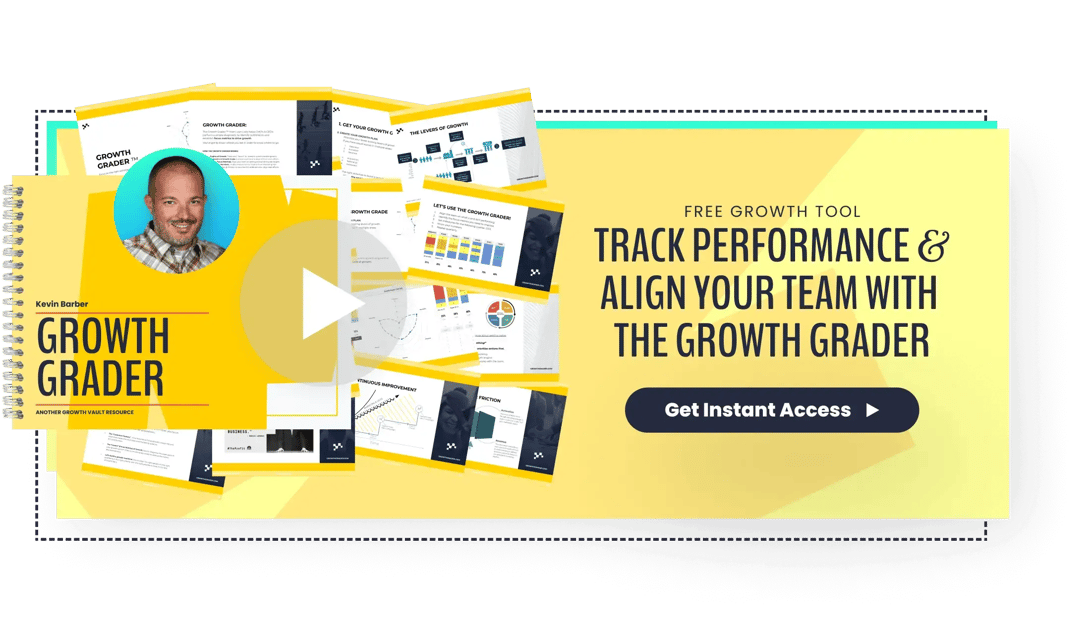When you search for “customer engagement strategy”, you’re likely to find a lot of best practice articles that talk about these benefits. And it seems straight-forward enough. All you need to do to master customer engagement and you’ll gain the loyalty of potential customers.
But in practice, customer engagement isn’t that easy.
While there are a ton of tactics for improving customer engagement, such as using Twitter for service and support, sending out weekly email newsletters, and holding live Q&As on Facebook Live, it can be challenging to fit all of these pieces into an overarching strategy.
However, there are a few tried and true tactics that make all these isolated pieces fit together, and when they do, it's golden.
VIDEO TRAINING
Get The Growth Marketing Playbook.
Learn to plan, budget, and accelerate growth with our exclusive video series. You’ll discover:
- The 5 phases of profitable growth
- 12 core assets all high-growth companies have
- Difference between mediocre marketing and meteoric campaigns
Thanks for submitting the form!
We'll review the information you've submitted and respond to you just as soon as possible.
How To Build A Customer Engagement Strategy
Here at Lean Labs, we use the term “customer-centric” to describe how we approach growth-driven design and inbound marketing.
The concept isn’t that revolutionary.
It’s what marketers have been doing since the ‘50s - putting ourselves in the customer’s shoes and creating an experience that meets their expectations and fits their needs.
You can see the process and methodology we have for websites and inbound here.
But as it pertains to a customer engagement strategy, I start with two critical documents: a buyer journey template and a customer journey map.
1. Build Out Your Buyer Journey And Customer Journey Map
%20(1).jpg?width=1419&name=buyer-journey%20(1)%20(1).jpg) First, there’s the buyer journey.
First, there’s the buyer journey.
This template helps you define the best content and messaging for each stage. For instance, let’s say that you’re a company like Rocket Mortgage, and you know that you’re going to offer an eBook about first-time home buyers applying for their first mortgage.
You can go back through every stage leading up to consideration and plan out content and engagement points to lead that person to your EBook, and inevitably, your core offer.
Then, there's the customer journey map.
.jpg?width=1606&name=customerjourneymaptemplate%20(1).jpg) You'll fill out a customer journey map that reflects the customer's current experience, as well as another map that documents their ideal experience.
You'll fill out a customer journey map that reflects the customer's current experience, as well as another map that documents their ideal experience.
.jpg?width=1608&name=customerjourneymapideal-min%20(1).jpg) This is a great way to brainstorm offers, find disconnects in the overall experience, and improve your website.
This is a great way to brainstorm offers, find disconnects in the overall experience, and improve your website.
2. Schedule Customer Conversations
It’s going to sound like basic advice, but you’d be surprised at how many companies neglect to talk to their customers. And I don’t mean during the sales process.
A lot of companies do not get potential customers (or existing) on the phone. They don't ask them about how they can improve or make their experience easier.
One time, I got on a call with the customer of one of my clients. I asked him a few questions about how he was using their platform day-by-day, and through that conversation, I found out that he was using the platform to solve problems that I (nor the client) knew existed.
Ideally, you’ll talk to 2-3 customers a month. You can hold these calls over Skype or Zoom and record them. The best questions you can ask to improve your customer engagement strategy include:
- How do you prefer to get updates about platform/product features?
- What kind of support would make using this platform/product easier?
- How often do you want to talk to a person, versus through email or social media?
- What frustrates you the most about using this product/platform?
- How often do you check your email and engage on social media with brands? Why?
You’ll get a ton of insights, and you can also save the content to pass along to your marketing team.
3. Create A Smarter Content Strategy
If you start a customer engagement strategy in tandem with your content marketing strategy, you can get a ton of inspiration for blog posts, videos, podcasts, and more. From that, you can create content that not only targets specific keywords but plays a critical role in customer engagement, as well as your marketing and sales processes.
For example, let’s say that you’re a consulting firm. You can make a beliefs video that explains your methodology and essentially, the value that you provide to potential customers.
You can repurpose that video into a few different assets, such as:
- A website page with the full video, as well as content that explains your methodology in full.
- A blog post that covers the topic in more detail that you can automate to go out a few times a month across social platforms.
- A shortened video that you can upload on LinkedIn and invite people to comment with questions and feedback.
- Clips of the video to use on Twitter and Facebook, which you can use to start conversations with potential leads.
- A welcome series that introduces new leads to your brand and beliefs.
All of this content can help drastically boost customer engagement, using just one asset.
4. Make Your Content And Engagement Points Mobile Friendly
If you’re like me, you’re on your phone a lot. And when you try to do something on your phone, like fill out a form or watch a video, and can’t do it from your phone, you rarely go back and try to do it again from your desktop.
That’s why all of your blog content, videos, website forms, and any other way a customer can engage or contact you must be mobile-friendly. Once you lose a potential customer, they probably won't come back.
Go back to the customer journey map and evaluate how mobile-ready your customer experience is.
Simply walk through each action that your customer could take and ask: how easy would this be to do from a phone?
I’d start with making sure:
- Each and every form on your website is easy to complete on a phone
- All of your video (even on your website) has subtitles and does not require sound to comprehend
- All of your blog posts are optimized for mobile (if you’re using HubSpot as a CMS, it will be)
You also want to make sure that you can quickly address the needs of people communicating with you on social channels.
For instance, what would happen if you were a SaaS, and someone tweeted at you because they were locked out of their account? If your process is to make them go through a lot of steps, it’s going to be difficult for them to do that from their phone.
A good way to identify potential friction with customer engagement is asking: what are the most frustrating things that can happen to our customer, and how can we make those challenges easy to resolve?
5. Plan For Breaks In Automation
Automation is great, and it can save you a ton of time. But there should be points within your customer engagement strategy where you plan for customers to converse with an actual person.
There are a few different ways you can approach this, but I’d go back to the customer journey map and find opportunities to surprise and delight your lead with human interaction.
You can personally answer questions and start conversations from your brand Twitter, leave thoughtful comments on Instagram posts, or follow-up with a customer via email instead of an automated response.
I’d recommend putting together a system to get your employees to hit a daily minimum of human engagement, whether they’re following up with customers to see how they’re doing or engaging on social.
Engaging Authentically With Your Customers
The key to putting together any customer engagement strategy is, of course, the customer. An effective customer engagement strategy equips you to meet your customer wherever they’re at. And with the right content, communication, and connection, you can help them overcome any challenge.

%20(1).jpg?width=1419&name=buyer-journey%20(1)%20(1).jpg) First, there’s the buyer journey.
First, there’s the buyer journey..jpg?width=1606&name=customerjourneymaptemplate%20(1).jpg) You'll fill out a customer journey map that reflects the customer's current experience, as well as another map that documents their ideal experience.
You'll fill out a customer journey map that reflects the customer's current experience, as well as another map that documents their ideal experience..jpg?width=1608&name=customerjourneymapideal-min%20(1).jpg) This is a great way to brainstorm offers, find disconnects in the overall experience, and improve your website.
This is a great way to brainstorm offers, find disconnects in the overall experience, and improve your website.




